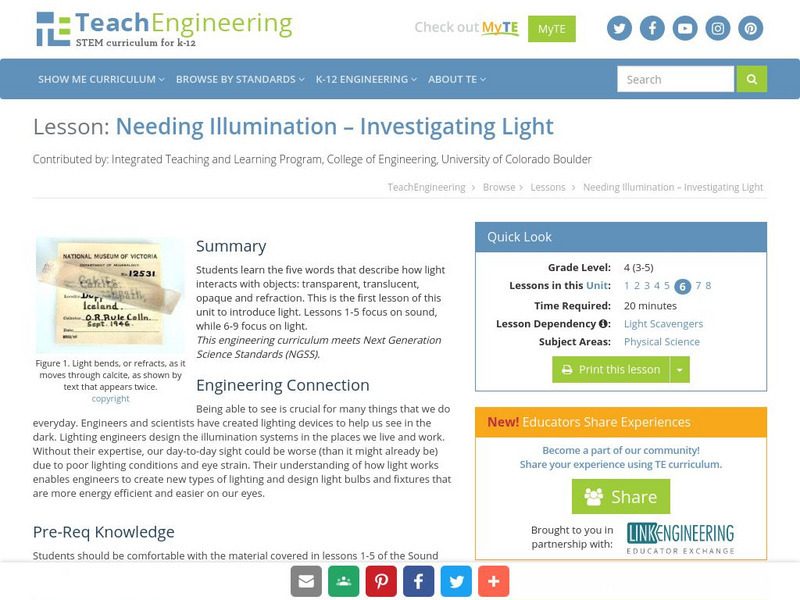CK-12 Foundation
Ck 12: Digestive System Organs
[Free Registration/Login may be required to access all resource tools.] In the following online lesson students will identify the organs and functions of the digestive system.
CK-12 Foundation
Ck 12: The Small Intestine
[Free Registration/Login may be required to access all resource tools.] In the following online tutorial students will explain how digestion and absorption occur in the small intestine.
TeachEngineering
Teach Engineering: Does Media Matter? Infiltration Rates and Storage Capacities
Students gain a basic understanding of the properties of media- soil, sand, compost, gravel- and how these materials affect the movement of water (infiltration/percolation) into and below the surface of the ground.
TeachEngineering
Teach Engineering: Exploring Light: Absorb, Reflect, Transmit or Refract?
In a hands-on way, students explore light's properties of absorption, reflection, transmission and refraction through various experimental stations within the classroom. To understand absorption, reflection and transmission, they shine...
TeachEngineering
Teach Engineering: Learning Light's Properties
Students learn the basic properties of light--the concepts of light absorption, transmission, reflection and refraction, as well as the behavior of light during interference. Lecture information briefly addresses the electromagnetic...
TeachEngineering
Teach Engineering: Security System Design
Middle schoolers apply everything they have learned about light properties and laser technologies to designing, constructing and presenting laser-based security systems that protect the school's mummified troll. In the associated...
Texas Education Agency
Texas Gateway: The Digestive System, Fact or Fiction?
In this lesson students read fun, gross, or interesting facts about the digestive system and they are introduced to several unfamiliar words and encouraged to "be on the lookout" for those words during the lesson.
University of Florida
Florida Museum of Natural History: Investigating Water
This guide engages children in the process of scientific inquiry using the context of a favorite early childhood pastime-water play.
BSCS Science Learning
Bscs: Medical Mystery
This is a free middle school science program that supports teachers in the effective instruction of an NGSS-aligned, EQuIP-reviewed body systems curriculum unit. Groups of students will solve a mystery ailment affecting a 13-year-old. A...
Georgia State University
Georgia State University: Hyper Physics: Hydrogen Energies and Spectrum
This site from Georgia State University gives information on the transitions of electrons between energy levels. The energy levels for electrons in the hydrogen atom are discussed. The Rydberg equation is stated and electron transitions...
Massachusetts Institute of Technology
Mit: Open Course Ware: Courses: Chemical Engineering: Separation Processes
College-level chemical engineering course highlighting the general principles of separation by equilibrium and rate processes. Course topics comprise staged cascades and applications to distillation, absorption, adsorption, and membrane...
Center of Science and Industry
Cosi Columbus: A Swell Activity With Beans [Pdf]
Learn about absorption in this hands-on science experiment. Includes full list of materials, procedures, and scientific explanation of what happens to different types of beans as they soak in water in a test vial.
University of Illinois
University of Illinois Urbana Champaign: Light and Optics
Rainbows and sunsets are called "atmospheric optics". They can be caused by light being absorbed, reflected, scattered, refracted, or diffracted by particles in the atmosphere. Learn all about different atmospheric optics along with...
Texas Instruments
Texas Instruments: Absorption and Radiation
Different surfaces absorb and radiate radiation at different rates. In this activity you will analyze the absorption and radiation rates of two surfaces by monitoring the temperature changes of each of them.
Texas Instruments
Texas Instruments: Collecting Solar Rays
In this activity, students' will use three Temperature Sensors to collect data from three solar collectors and determine which one absorbs the most heat. They will develop an understanding of the difference between absorption and...
Science Education Resource Center at Carleton College
Serc: Rain Erosion: Does the Rate of Water Effect Erosion?
In this lab, students investigate whether the rate of water falling (rain) affects the amount of erosion (soil movement). This experiment could lead to further questions: how does grass or rocks effect soil erosion, does erosion lead to...
Friesian School
Proceedings of the Friesian School/the Quantacized Atom
A very lengthy page from friesian.com discussing Bohr's theory of electronic energy levels and the explanation of commonly observed atomic emission line spectra. The concept of a photon and Einstein's observation of the photoelectric...
PBS
Nova Teacher: Saved by the Sun: Classroom Activity
During the lesson, students will also design, build and test a solar cooker that pasteurizes water.
Other
University of California: Acoustics for Music
A discussion of the acoustical features of a room and their effects upon the perception of sound. Topics such as absorption, reflection, and reverberation are clearly discussed and cleverly illustrated.
State University of New York
State University of New York: Chromatography and Equilibrium
The following simulation explores the process of of chromatography and equilibrium.
University Corporation for Atmospheric Research
Ucar: Atmospheric Processes Radiation
This site provides background information, images, and an activity to help students understand the concept of radiation. Includes both the student pages and a teachers guide with lesson plan.
TeachEngineering
Teach Engineering: Controlling Sound
In this activity, students use a variety of materials to design and create headphones that absorb sound.
TeachEngineering
Teach Engineering: Needing Illumination: Investigating Light
This is the first lesson of this unit to introduce light. In this lesson, students learn the five words that describe how light interacts with objects: "transparent," "translucent," "opaque," "reflection" and "refraction."
Physics Classroom
The Physics Classroom: Blue Skies and Red Sunsets
This high school resource shows how the blue of the skies and the red of the sunsets can be explained by the interaction of sunlight with atmospheric particles which causes scattering of light.























